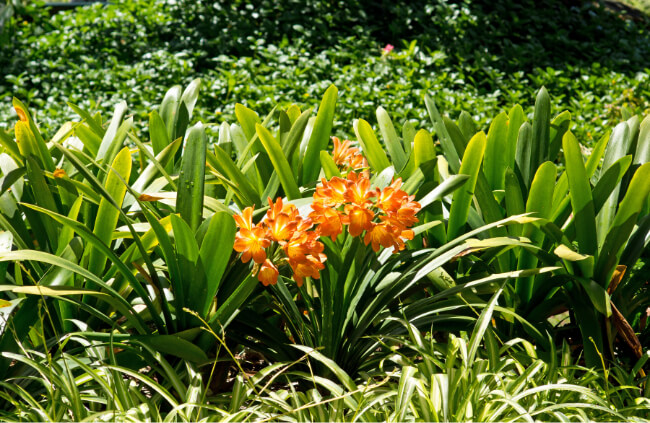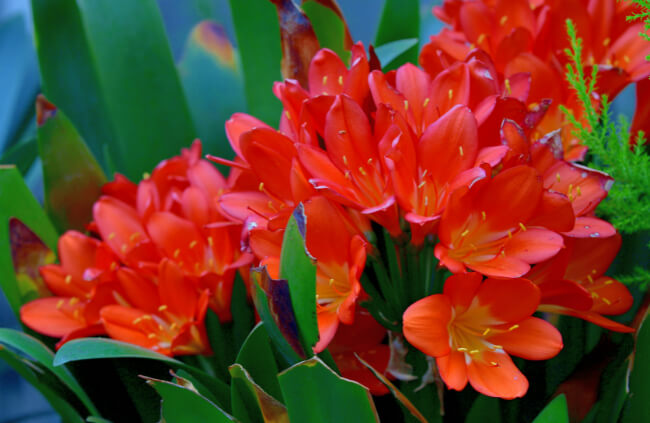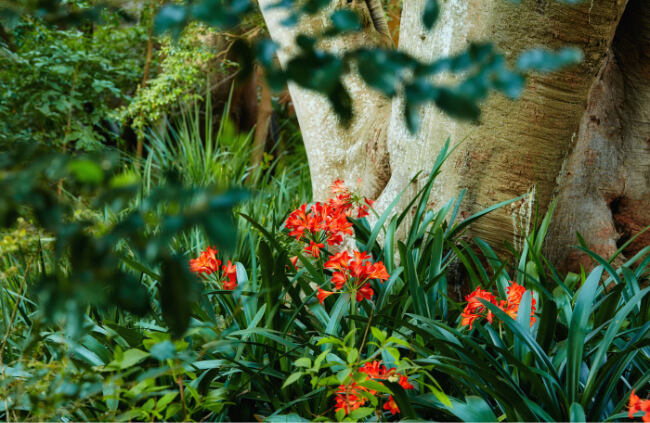Clivia miniata is a plant that truly transforms a landscape, thanks to its magnificent flowers. It’s native to South Africa and Swaziland where it lives in the shade of forests, but doesn’t shy away from more challenging growth areas like rocks on slopes and even in the crevices of a very large tree trunk.
Perhaps this is also what makes it charming – the ability to be flexible and find a home in unlikely places. In this guide, we explore more about Clivia miniata, the bush lily or Natal lily as it’s also known.
Learn how to propagate your own, and what this beautiful plant needs in terms of care in order to thrive. We’ll also share some common pests to watch out for and how to deal with them.
More...

Family: | Amaryllidaceae |
|---|---|
Genus: | Clivia |
Species: | C. miniata |
Common Names: | Bush lily, Natal lily |
Origin: | South Africa and Swaziland |
Location: | Outdoor and indoor |
Type: | Flowering plant (Perennial) |
Growth: | Up to 60 cm tall and 90 cm wide |
Sun requirements: | Shade with some partial sun |
Foliage Colour: | Dark green |
Flower Colour: | Red, orange, yellow |
Flowering: | Spring |
Fruit: | Bright red berry with a few seeds, not edible |
Maintenance level: | Low |
Poisonous for pets: | Yes |
Introducing Clivia miniata
If you’re in search of a plant that loves shade or something interesting for a pot, you’ll find it in the Clivia miniata. It has strappy dark green leaves and flowers of bright orange and sometimes yellow that delight in spring. It can also flower at random during other parts of the year.
The Clivia genus originated in South Africa where it grows happily in the wild. When the conditions are right, it will grow in big clumps and once established, is not demanding of water.
Clivia miniata has naturalised in Mexico and you’ll find it in many of the older suburbs in Australia. The Natal or bush lily is also loved in New Zealand, Japan, China and the United States.
It’s probably no surprise then that the Clivia miniata, along with Clivia nobilis, has earned itself a Royal Horticultural Society Award of Garden Merit.
Check out our main Clivia article for more details on its different species.
How to Grow Clivia miniata in Australia
The Clivia miniata grows slowly and can take up to 5 years to reach maturity. You’ll notice that each stem produces one main flower and then eventually this forms clumps for maximum floral beauty. The flowers also last for a few weeks at a time.

Propagating Bush Lily
If you fancy having a Clivia miniata in your own garden, you can propagate the plant from seed or using existing plant suckers.
How to Propagate Clivia miniata Using Seeds
The seeded fruit of the plant is usually a bright colour once they are ripe and you can remove the pulp and seeds when needed. When you are ready to start sowing seed, make sure you remove all the pulp first.
We recommend using fresh seed wherever possible and be sure to wash your hands after handling it. Clivia miniata seeds can be planted in containers with a seed mix and you can push them down until they are just level with the surface of the mixture which should be kept moist.
The seeds can take between 4 and 6 weeks to germinate and in some cases, they can stay in the planting container for 2 years before being transplanted.
Clivia miniata Propagation by Division
You could also opt for the method of dividing up large clumps. You can do this with a fork, knife or sharp spade. Use the plant offsets that appear through the roots of the plant and you can remove each one where it meets the main plant.


Get Your Free Guide:
Master Growing Australian Natives eBook
A Must Have Complete Guide for Every Australian Garden
Get Your Free Guide:
Master Growing Australian Natives eBook
A Must Have Complete Guide for Every Australian Garden
Aim to do this as soon as you see the last of the flowers drop off the plant. Also check that each offset has a minimum of 3 leaves and these should be 20 cm or more in size.
You can plant the offset in a pot about 12 cm in size and fill it with coconut coir and perlite. Keep it somewhere warm with medium light. You can give just enough water to keep the mixture moist each time but you ultimately want the top of the mix to dry out between each watering.
Once you notice roots peeping out, you can then transplant your Clivia miniata into a slightly bigger pot and use a potting mix that is soil based.
Usually, you will get flowers a year after you have removed the offset from the main plant but in some cases your Clivia miniata might not produce flowers for a few seasons once they have been split.
If you are wanting a plant that is true to the original in colour, it’s best to divide up existing plants. In the case of seed, the outcome of the new plant colour cannot be guaranteed and doesn’t always resemble the parent plant.
How to Care for Clivia miniata

Sunlight
The best place to plant bush lily is in dappled shade. Clivias don’t do well in sunlight and can get burnt quickly. Your Clivia miniata will be happy growing in shade. Too much sun affects their leaves and flowers. A good spot to make sure they are protected is planting them under trees or shrubs.
Soil
Soil should have plenty of compost and excellent drainage which is a must for Clivia miniata. We recommend adding compost and some slow release fertiliser to the soil before planting. You can top up the garden beds each year with a good amount of organic mulch.
Watering Bush Lily
Water your Natal lily often during summer time as this is when they are growing. When winter comes around, you can cut back on watering as the Clivia miniata can handle a lengthy dry period during this season as it goes into a rest phase.
When the plant is young, they need lots of water in spring and summer when the weather is dry. A good watering twice a week is plenty. When they are established, they are then much hardier.
Pruning
When the flowers are finished blooming and fall off the Clivia miniata, there are small fruits left behind. Remove these from the plant before they have a chance to develop.
If they stay on the plant, they become big and steal all of your plant’s energy. This can cost the plant its flowers for the following spring time. You can also remove the flower stems at the base.
Bush Lily Fertiliser
Your Clivia miniata enjoys a good feeding. You can use a slow-release fertiliser or a liquid option straight after flowering and apply often, starting from the beginning of spring all the way into the middle of summer. This will help to promote growth.
Temperature and Climate
The Natal lily is sensitive to frost and doesn’t like cold wind. Make sure your Clivia miniata is well sheltered. The plant likes warmth when it’s in the active growing phase but needs a rest period during winter (about 2 months).
During this time, they should be kept around a temperature of 10°C. If the temperature is too warm, the flowers might not last as long.
Bush Lily Indoor Care

The bush lily does really well grown in a pot, as long as it has a well-draining potting mixture and a generous dose of compost. That’s what makes it a popular choice as an indoor plant that is quite low maintenance.
If your Clivia miniata is in the process of flowering, don’t move it and keep the leaves free from dust by wiping them with a cloth. You can place your plant in a window that has bright light early in the morning and later in the afternoon.
If the spot gets midday sun it will probably be too much for the leaves. On the other hand, if the Clivia miniata doesn’t get enough light, the plant might not produce any flowers.
Potting and repotting
You can aim to repot your Clivia miniata every three to four years. You only need to repot when the roots have completely filled the current pot. For the years in between the repotting, you can top dress with potting mix and pack it tightly around the roots.
As the roots grow, they push the potting mix up so allow some room for this at the top of the pot. We recommend clay pots instead of plastic ones. When you repot, you can increase the size by about 5 cm each time.
When the bush lily has reached its maximum size, you can then start top dressing with fresh potting mix each year instead of repotting. You can remove about 5 cm of the older potting mix and put in some fresh one.
Add some bone meal as well. The best time to do your repotting and top dressing of potting mix is at the end of winter as this is when the flower stalks start to grow.
Common Clivia miniata Pests and Diseases
Slugs and snails
These pests can cause plenty of destruction to the leaves and flowers of your Clivia miniata if you’re growing it outside. You can treat with a pellet or liquid form of deterrent, and picking them off the plant when you see them is also effective.
Mealybugs
If you notice what looks like white wool on your leaf surface, you’re probably dealing with mealybug. Aside from using an insecticide, you can also dip a cotton swab in alcohol to remove them from the plant, or use soapy water to wipe down the parts of the plant that are affected. You can use this same treatment for scale and spider mites.
Aphids, white fly and thrips
If you’re dealing with a big infestation of these pests, they can cause a considerable amount of damage. You can use an insecticide or something organic like neem oil to disturb the life cycle of the pests.
Below are some of our in-depth guides to dealing with pests:
Frequently Asked Questions About Clivia miniata

Where does the Clivia miniata get its name?
The Clivia genus is named after the Duchess of Northumberland, Lady Charlotte Clive. She was the first to cultivate this flowering plant in England. The name miniata means red lead colour and describes the clivia flowers.
What is the history of Clivia miniata?
The Clivia made its first journey from South Africa to England during the 1800s when specimens were sent over. During the Victorian era, the Clivia was often grown indoors in homes around England and Europe.
The Clivia miniata in particular made its appearance at the end of the 1800s.
How has clivia been bred to create so many wonderful varieties?
The four species of Clivia, namely C. nobilis, C. gardenii, C. caulescens, and C. miniata have been bred to create some interesting qualities including massive flowers with lovely colour, leaves arranged in a fan shape, but also variegated and dwarf varieties. Japan in particular is known for advanced breeding of clivias.
What makes clivia poisonous?
Clivias contain small quantities of the alkaloid lycorine. You would need to consume quite a large amount of the plant for a toxic reaction but better to err on the side of caution. Symptoms of a toxic reaction include vomiting, low blood pressure, and tremors.
All parts of the Clivia miniata are toxic but the bulbs have the highest concentration of lycorine.
Why is my Natal lily not flowering?
There are 3 possibilities here – not enough nutrition and feeding for the plant, too much water, or too little water. Inspect the plant roots and get rid of any that are dead and rotten. If the plant is in a pot, you’ll need to replace the compost.
What does it mean if my Clivia miniata has brown patches on the leaves?
This usually means the leaves have been scorched and can occur if the plant is next to a window and even if drops of water have accumulated on the leaves.
My bush lily has short stems and there seem to be more leaves than flowers. Why is this happening?
It’s possible that the temperature during the winter wasn’t right. The plant needs a certain amount of time to be cool during this season. We recommend maintaining a temperature around 10°C.
Sign up for our newsletter for more gardening tips, plant profiles, and inspiration.
Wrapping Up Our Clivia miniata Guide
Clivia miniata make great garden plants if the climate for your area is suitable. I’ve seen them used as border plants and also planted in large quantities, creating a stunning visual effect. I love that Clivia miniata are versatile, growing well in the garden and just as easily in a pot indoors, or on the balcony.
Published on June 7, 2023 by Maisie Blevins
Last Updated on February 25, 2024




